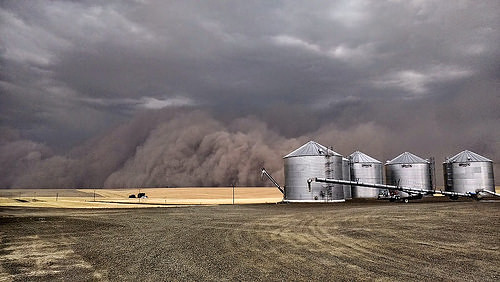By Camille St. Onge, communications
Eastern Washington’s nutrient-rich soil is perfect for
agriculture, but it’s also a perfect starting place for dust storms, ranging
from simple dust devils up to massive haboobs.
Much of Eastern Washington is blanketed with a fine-grained
soil called “loess.” It’s mainly found in the Columbia Plateau and Palouse
region of Southeastern Washington. Loess is rich in organic nutrients and vital
for agriculture such as wheat farming. It also sets up conditions nicely for
dust storms in the region.
Is it comparable to Dust Bowl of the 1930s — a terrible natural
disasters in U.S. history? Not really. But, with more droughts and extreme
weather projected because of our changing climate we’re likely to see more of
these gnarly dust storms in the future here in Washington.
Let's break it down
If you live in Western Washington you may be asking yourself,
what dust storms?
On the west side, the warm winds kick up an occasional dust
devil - strong, well-formed whirlwinds. A dust devil can range from 30 feet to
as much as a 3,300 feet tall, but few in the west part of the
state last long
enough to cause real problems.
 |
| Dust devil |
East of the Cascades, blowing dust is a much different story
because the geological makeup of the region is very different.
Eastern Washington’s soil is a legacy of the flooding and
erosion caused by retreating glaciers at the end of the last ice age about
10,000 years ago. These massive floods left behind the characteristic
“channeled scablands” of dramatic buttes and mesas.
As the Earth’s climate became warmer, these channeled
scablands dried and soil began to blow away. Over time, the soil has been
constantly blown and redeposited, producing the landscape we see in Eastern
Washington today.
Today, a strong gust of wind can easily sweep up the soil
and can carry it for miles.
And then there’s the dreaded
haboob.
According to Clint Bowman, atmospheric scientist with the
Department of Ecology, haboobs are like a dust storm on steroids.
Haboobs occur when a thunderstorm creates a strong downdraft
of cold air, which slams into the ground and spreads out like a pail full of
water hitting a concrete walk. The effect produces strong winds right at ground
level, where they scour the soil and can build into a devastating wall of dust
and dirt.
In 2014 and 2015, haboobs in Eastern Washington brought
visibility to zero, knocked out power, caused several car accidents, and forced
officials to close highways as it moved through multiple Washington counties
before dissipating over the Idaho Panhandle.

Dust can be gross
Dust can be made up of pollen, bacteria, smoke, ash, salt crystals from the ocean, and small bits of dirt, rock, or sand. It
may also contain tiny fragments of human and animal skin cells, agricultural chemicals, and hair. Take a moment and think about breathing that in.
One of Ecology’s roles is to warn about air pollution issues
that could affect people’s health.
Infants, small children, asthmatics and people with other
respiratory and cardiovascular diseases are affected more than the general
public, and prolonged exposure to blowing dust can lead to serious respiratory
problems for these groups.
The National Weather Service looks for potential visibility
issues that could create hazardous driving conditions. The limited visibility
during major dust storms sometimes leads to severe car accidents.
Because of our mutual interest in warning communities of
these hazards, the National Weather Service and Ecology work together to get
the word out through “blowing dust advisories.”
Local television and radio stations share the warnings, and
both agencies use social media to spread the word.
Dust bowl no more!
Did you know that the Soil Conservation Service was formed
during the Great Depression to address the soil erosion that caused the Dust
Bowl? This agency was the forerunner to the USDA's Natural Resource
Conservation Service. The NRCS and local conservation districts assist growers
to implement soil erosion conservation measures today.
Fortunately, the Washington
agriculture industry actively uses erosion control practices and works in
partnership with Washington State University’s College of Agriculture to employ
best practices to minimize erosion. WSU has developed farming practices
that allow growers to control wind erosion and dust emissions, and to assist
them with adopting these practices on their farms.
Ecology does its part by monitoring
dust storms and working closely with the U.S.
Environmental Protection Agency to ensure it is aware when dust storms cause
air pollution levels to exceed federal air quality standards.
 |
| Melbourne, Australia |
Dust storms in Washington and around the world
While dust storms in Washington can
cause health and driving risks, our state does not face the extreme dust issues
facing other dry and arid states and countries do. The 1983 Australian dust storm that covered the city of Melbourne was a
famous example of the power of these storms: The deserts of Australia were
experiencing drought, so sand and soil were loose. The dry conditions set
up about 50,000 tons of material to erode as dust. A
strong cold front brought winds that swept up that dust and, over the course of
a single afternoon, choked Melbourne under an estimated 1,000 tons of dust. It
took years of work and millions of dollars to repair the damage caused by the storm.
Check out dust devils, dust storms, and haboobs from around
Washington and the world by exploring the links below. For more information
about blowing dust in Washington visit our outdoor dust page.
Dust devils, dust
storms, and haboobs:
- Washington state dust devils
- Washington state haboobs
- Washington state Google dust storm search
- Google dust storm search
- Google search haboob
- 1983 Melbourne, Australia haboob
- Historical Texas dust storms
- Phoenix Dust Storm on YouTube
- Lubbock, Texas dust storm slide show
- Eastern Washington CBS dust storm news story


No comments:
Post a Comment